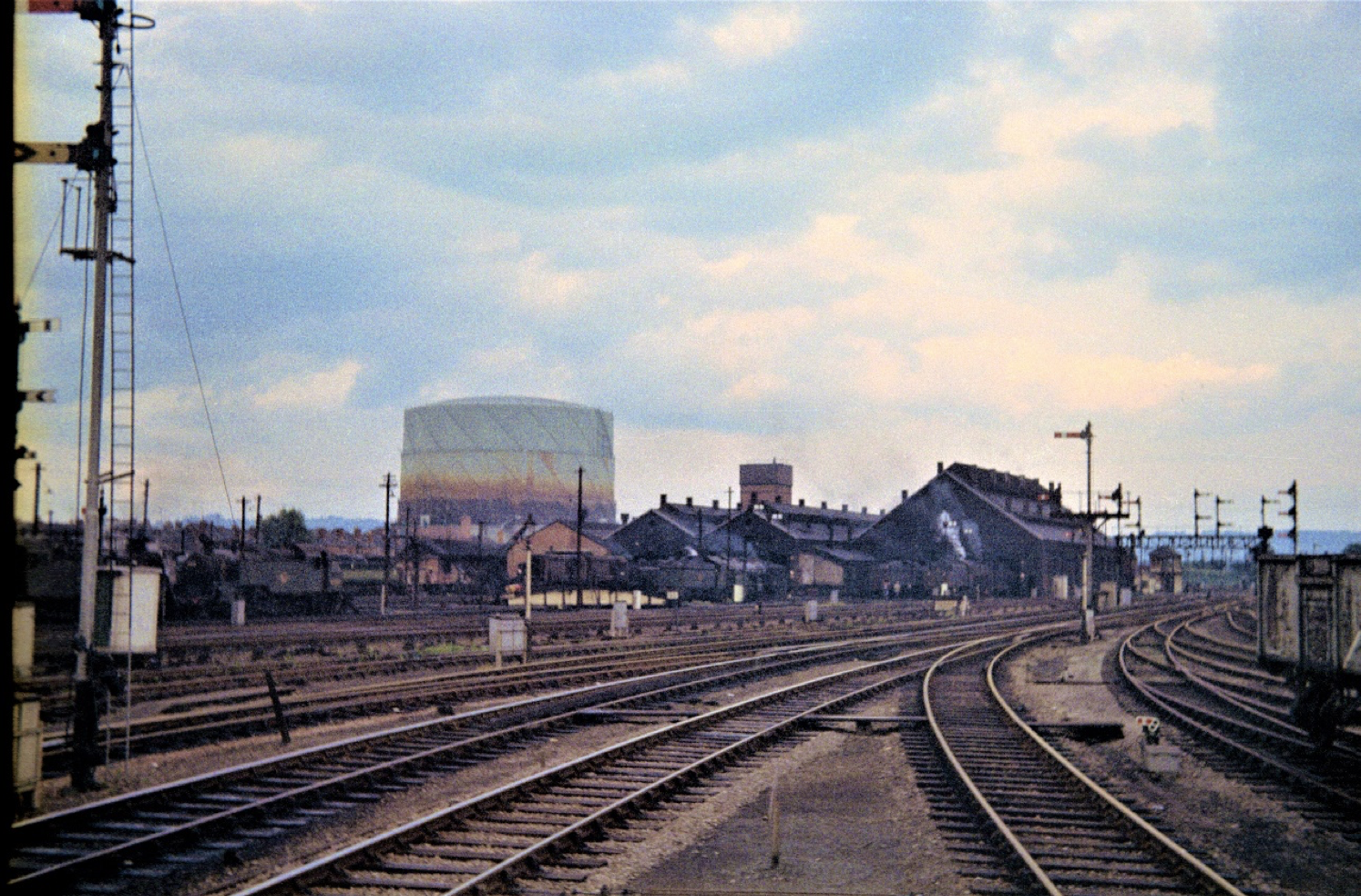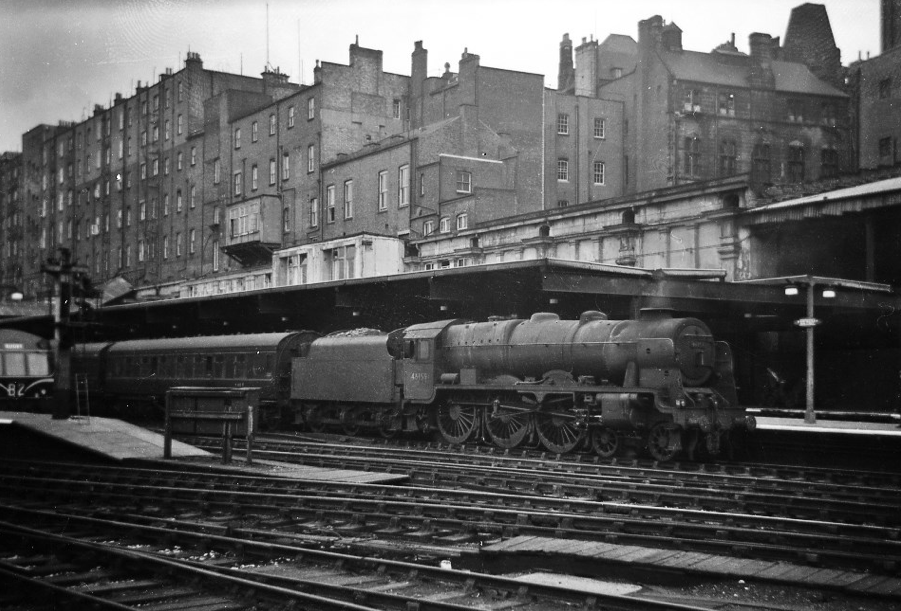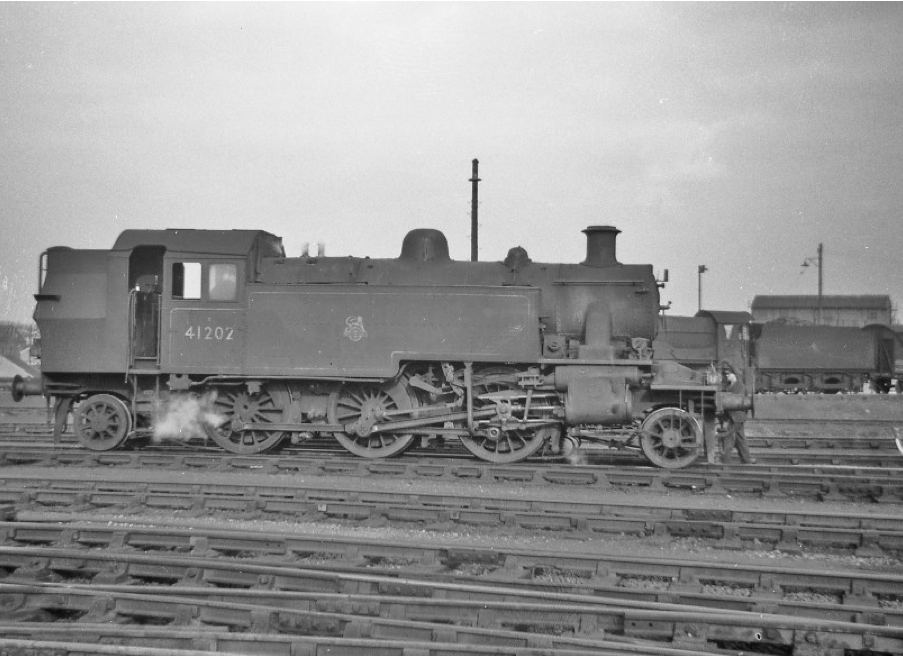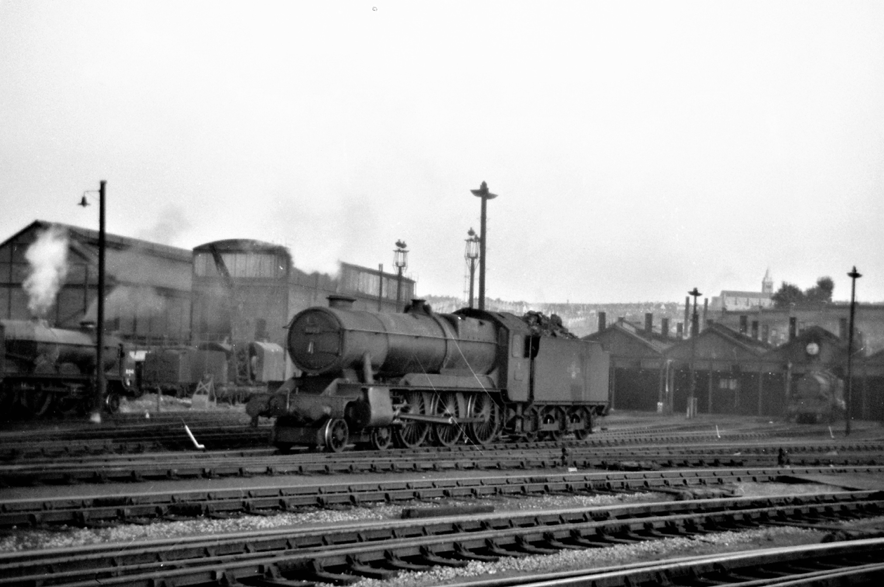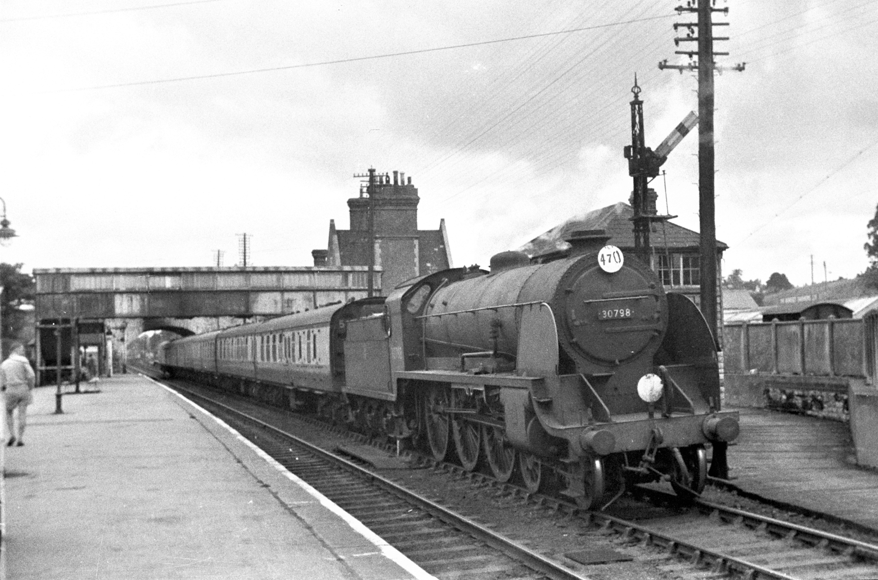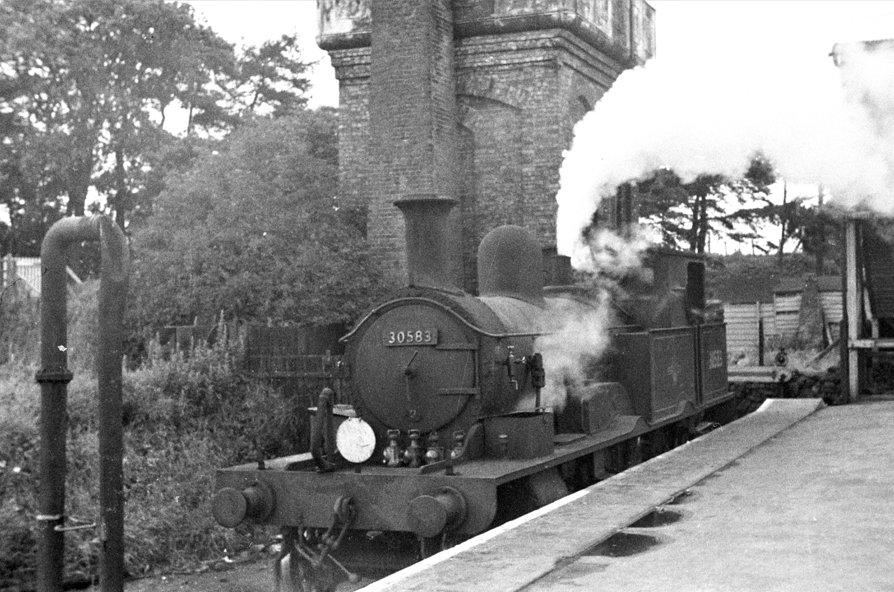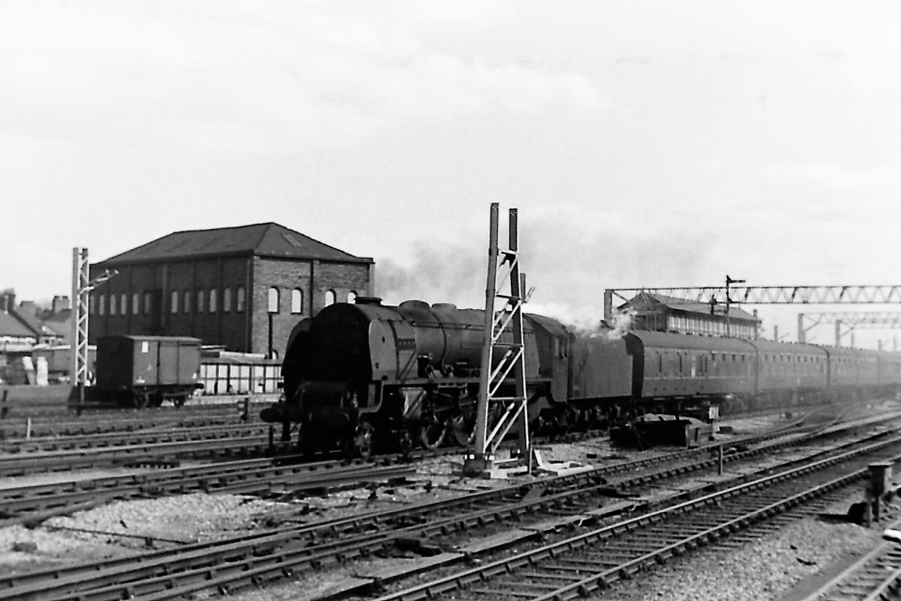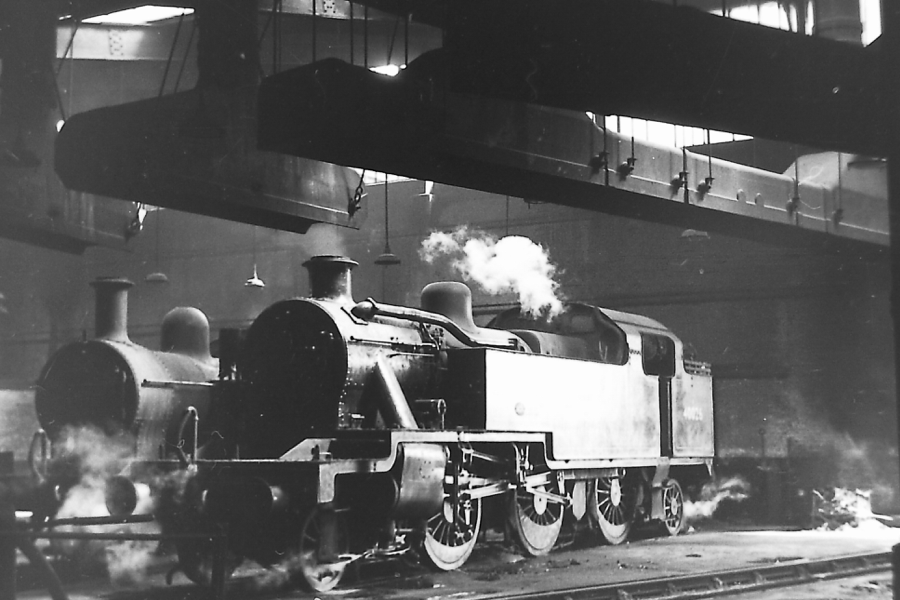Early Day Trips
Early trips to the West Midlands
Partly inspired by the family holiday trip to Rhyl in 1958, I went spotting with Roger to Birmingham New St on 11 July 1959, where I photographed ‘Scot’ No. 46159 The Royal Air Force and ’Britannia’ No. 70043 Lord Kitchener on expresses from Glasgow and Manchester respectively.
We passed through Birmingham quite frequently on trips to Tamworth to see big main-line steam in action on the Euston – Crewe route. There was a field to the south of the Trent Valley line, and east of the High Level station next to a caravan site, where train-spotters gathered and both lines could be seen. On the Low Level line, a shout would go up ‘Peg on the main’ when a train was signalled, and as the locomotive came into sight someone would shout ‘Jube’, occasionally turning into an excited cry of ‘Prinny’! Our favourites were the ‘Semis’ as we called the ‘Duchesses’. If we were lucky, we would also see one of the five main-line diesels working on the West Coast at that time; the two Derby examples (Nos. 10000/1) being supplemented by three designed by Bulleid for the SR (Nos. 10201-3). On a later trip, the prototype ‘Deltic’ was seen working the Midday Scot – most impressive! Whilst speeds through the Low Level station were often quite high, the High Level line could produce surprises – I remember on one occasion a ‘Black 5’ rushing northbound on an express, with the grinning fireman holding a rag across the loco’s number to ensure it could not be identified! I also travelled once to Lichfield Trent Valley, but the trip wasn’t very successful, as there were no real vantage points to see West Coast trains, and local services using the High Level platforms from Birmingham New Street and Wolverhampton to Burton-on-Trent were already being worked by DMUs. I do however have a photograph of a ‘Scot’ pulling into the station on a northbound Manchester express.
‘Royal Scot’ 4-6-0 No. 46159 The Royal Air Force having arrived at Birmingham New Street from Glasgow, prepares to take out the empty stock to Vauxhall & Duddeston on 11 July 1959.
Bristol
Bristol was a popular destination for a local trip from Gloucester. Around 1958-59, one regular excursion was to go to Bristol Temple Meads on a Saturday afternoon, catching the 2.33pm from Gloucester. This train, being a 41C turn was often headed by a ‘B1’, one of the first I saw being No. 61033 Dibitag. We were usually ensured a good trip, as the load was a light one, being made up on alternate days of a 5-coach WR set of Hawksworth coaches, or a 6-coach set of LM Stanier ones. Our return journey would be made either on the northbound ‘Cornishman’ at 4.8pm behind an 84A ’Castle’, or the up TPO mail departing Bristol at 7.25pm for Newcastle. The latter was preferred though, as this service was rostered for a 55A ‘Jubilee’ (Holbeck was 20A when an LM depot).
In 1956, ‘Castle’ No. 7018 Drysllwyn Castle had received a double chimney to improve performance, and soon other Castles were being similarly fitted, and additionally with four-row superheaters. 7018 often worked ‘The Bristolian’ in its early days, and I remember seeing it on arrival at Bristol with a dead chicken in its running gear! The ‘Bristolian’ was steam-hauled for the last time on 12 June 1959.
A key event at Bristol was waiting the 4.15pm Paddington to Plymouth, hopefully for a sight of an 83D ‘King’. On another occasion I managed to photograph my last ‘Castle’ No. 5069 Isambard Kingdom Brunel (83D) at the head of the afternoon westbound parcels train. The Brown-Boveri gas turbine, No. 18000, (nicknamed ‘Kerosene Castle’) spent a lengthy period out of service in Swindon works in 1956-57, but we saw it several times in action on its regular turns to Bristol and Weston in 1958-59, although it was finally withdrawn at the end of 1960. However, its Metropolitan-Vickers counterpart 18100, which I never saw in service, was withdrawn in Spring 1958.
On one of our early Bristol trips, on 3 September 1959, I photographed steam on 82A from the end of the platform, then a busy shed. Locos included ‘County’ No. 1009 County of Carmarthen, ‘Castle’ No. 5054 Earl of Ducie, Ivatt ‘2’ No. 41202 and ‘Britannia’ No. 70024 Vulcan. Even then DMUs were making their presence felt, as since June a fleet of GRC&WW and Swindon built 3-car Cross-country and suburban units had been working local services based on Temple Meads.
Ivatt Class ‘2’ 2-6-2T No. 41202 on shed at Bristol Bath Road on 3 September 1959. The loco still displays the old BR ‘lion and wheel’ emblem on its side tanks.
‘County’ class no. 1009 County of Carmarthen manoeuvres onto Bristol Bath Road MPD on 3 September 1959, viewed from the end of Temple Meads station.
I was also taking an interest in train timing, spurred on by Cecil J Allen’s monthly articles on train performance in Trains Illustrated, although reports of happenings on the Bristol to Birmingham line in that magazine were noticeable by their absence. Thus, on 7 September 1959 I travelled down on the 2.33pm behind ‘B1’ 4-6-0 61318 (40B), at the head of a nine-coach train of LMS Stanier coaches. Not all Midland men liked the ‘B1s’, but this loco reached Bristol in 45½ minutes gaining 7½ minutes on schedule after leaving Gloucester 8 minutes late. Top speed was 84 mph in the dip before Coaley Junction. We returned that day on the northbound ‘Cornishman’ headed by one of 84A’s regulars, ‘Castle’ No. 5031 Totnes Castle, loaded to 10 coaches. After a steady start up the 1 in 75 through Fishponds, and a slow pass through Mangotsfield, we took up speed and reached 80 mph on the downhill stretch from Wickwar through Berkeley Road to Coaley Junction, reaching Gloucester in 48½ minutes, a gain of 6½ minutes on schedule.
Later, on 16 July 1960, I timed an impressive run back to Gloucester on the 7.25pm Bristol – Newcastle TPO. The train was headed by ‘Jubilee’ 4-6-0 No. 45716 Swiftsure, a Kingmoor loco that had been requisitioned by Holbeck in the absence of any of their own Jubilees, and a rarity in these parts. Furthermore, it was only equipped with a small Fowler tender. Loaded to 11 bogies, including 4 TPO vehicles, the ascent to the Mangotsfield stop was slow if solid with speed falling to 21 mph through Fishponds. However, once away from Mangotsfield the ‘Jubilee’ got into its stride, living up to its name and reached Gloucester in just over 33 minutes for the 31.9 miles, with a maximum speed of 74 mph at Charfield.
One of my best trips northbound was on the 5pm Bristol to Derby, a 17A turn, which on a day in June 1961 was worked by one of Derby’s new acquisitions, ‘Royal Scot’ 4-6-0 No. 46106 Gordon Highlander, fitted with Standard smoke deflectors. The train was loaded to 11 bogies, including a Griddle car and two vans, and made a good climb to Mangotsfield attaining 44 mph by Staple Hill. Gloucester was reached in 34 min. 19 sec. from Mangotsfield, again without speed going above 70 mph. I also recorded other southbound trips with Standard ‘5’ No. 73048 (41C) on the 2.33pm, and ‘Castle’ No. 7026 Tenby Castle on the ‘Cornishman’, both of which were achieved in around 48 minutes against a 53-minute schedule, without speed exceeding 70 mph.
Another regular excursion destination was Weston-super-Mare. Locking Road station was used to service excursion trains which were frequent visitors in the late fifties. The station was a terminus just to the north of the General station which was set on a sharp curve on the loop off the Bristol – Taunton line. Excursion trains would often by-pass Temple Meads, and on one trip to Paignton on the Gloucestershire Holiday Express in August 1959 we stopped outside St Phillips Marsh MPD for a crew change and await the road. This gave me the opportunity to take my first picture of a 350 hp diesel shunter, No. 13001.
In those days it was possible to take a pleasure sailing on the Bristol Channel on one of Campbell’s paddle steamers from the from Weston’s Old Pier across to Penarth. We would also visit another of our early holiday venues, a caravan site at Sand Bay using an open-topped bus on route 152. It was still worked then by three 1939 Bristol Ks with Bath registrations: GL6611/2/4 (3810/1/3). They were eventually retired at the end of the 1961 season and replaced with a batch of open-topped FSs, 8576-9 (866NHT, etc.).
South Wales
Another regular excursion trip from Gloucester was to Barry Island: our locomotive and train would often be the largest to be seen there, being hauled by a ‘4300’ class Mogul or a ‘Grange’. Although frequently loaded to 10 coaches, this was not a problem, as the route down the Severn Estuary was level. What was remarkable however was the sheer volume of traffic that the Island station had to handle. Train after train from the Welsh Valleys would arrive, comprised of 8 or more non-corridor coaches headed by a ‘5600’ 0-6-2T, or occasionally a ‘Prairie’ tank of the ‘5100’ class. In the evening returning excursions would be drawn in by one engine, and once the train engine had been coupled to the other end and its had departed, the released engine would then attach itself to the next departure. Standard ‘3’ 2-6-2Ts had been allocated to 88C from 1955 to work local services, so the number of 0-6-2Ts used on passenger turns declined somewhat. Then, in 1958 DMUs were introduced to the Cardiff Valleys, and thus the days of local steam-hauled excursions were numbered.
I also went on several early trips to South Wales, one timing a 6-car DMU from Gloucester to Newport on the 9.36am to Carmarthen. Needless to say, speed was held at the 70-mph mark wherever the line speed allowed. The Eastern and Western Valleys services from Newport were dieselised in 1957 in an attempt to make them viable. I do not remember these services prior to the introduction of the Derby-built 3-car suburban DMU in the W50050 series, but their introduction only postponed the inevitable, and services were withdrawn on 30 April 1962.
‘Britannias’ were allocated to Canton from 1955 to work the heavy Cardiff – Paddington expresses, and worked well, although they were not so popular on the North-west route to Shrewsbury. However, they were certainly valued more than their stablemates had been in the south west, so the whole of the WRs allocation eventually ended up at 86C. On 20 November 1955 No. 70026 Polar Star was derailed at Milton, west of Didcot. The accident had been caused by drifting steam and handrails on the windshields obstructing the driver’s view of the signals, and as a result, the handrails were replaced by handholds. ‘Britannias’ continued to work on these expresses, including the ‘Red Dragon’ up to June 1961, but the whole of Canton’s allocation (apart from Nos. 70015/7/21 which had already been transferred to 9E) was transferred to the LM Region at the end of the summer timetable. ‘Kings’ had their final swansong on South Wales services from late 1960 until the withdrawal of the entire class at the end of 1962 and their replacement initially by ‘Hymeks’ (based at the new Bristol Bath Road diesel depot).
One rather poignant trip was with my sister Veronica, when one Thursday, probably in 1959, we took a trip to Llanelly. We travelled by DMU to Cardiff, where we caught the 11.10am to Swansea, which I timed as far as Bridgend. The load was 6 coaches, and the loco was ‘Castle’ No. 5006 Tregenna Castle (87E), but the performance was unexciting. The eastern approach to Swansea over the Skewen arches was memorable because of the lunar landscape it crossed, the result of many years on nonferrous metal refining. The journey out of Swansea climbing Cockett bank (two miles averaging 1 in 52) behind another loco was quite impressive though. I particularly remember buying Veronica a copy of ‘How Green was my Valley’ from the Wymans bookstall on Llanelly station.
1960 – Axminster
On 1 September, I went to Axminster for the day to see the Adams ‘radial’ tanks on the Lyme Regis branch as they were soon to be withdrawn. This meant getting up extremely early to catch the 6.28am works stopping train to Bristol, behind ‘Jubilee’ No. 45690 Leander, on the last leg of a diagram back home. A workers return cost 7/0d. After spending nearly an hour at Bristol, I caught the 5.30am Paddington – Penzance (C21), which left at 8.50am behind an 82C ‘Castle’ No. 5068 Beverston Castle. The fare to Exeter was 17/6d. At Exeter St David’s, ‘Z’ 0-8-0Ts were now on banking duty, but a lot of antiquated steam power was still around, e.g. ‘M7’ 0-4-4T Nos. 30024/5/45, ‘700’ 0-6-0 Nos. 30317/670/6, and a ‘T9’ (30718). However, the Exmouth branch was now being worked by Standard ‘3’ 2-6-2Ts. The fare to Axminster was 4/3d, and I travelled behind ‘WC’ Pacific No. 34108 Wincanton. The branch was in the hands of Adams 4-4-2T No. 30583, which was duly photographed, along with ‘King Arthur’ 4-6-0 No. 30798 Sir Hectimere. The Adams tanks were not to last much longer though and the whole class of three had been withdrawn by July 1961. However, subsequently, no. 30583 was rescued and restored as 3488 on the Bluebell Railway, which I was to see on a visit there several years later.
I returned to Exeter behind ‘WC’ No. 34015 Exmouth at 3.32pm. Performance over this switchback route was generally very impressive, particularly the rapid acceleration eastbound from Exeter to Broad Clyst and the fast speed of my westbound train through Seaton Junction. These performances are recorded elsewhere. But dieselisation had started in the south-west as the 5.20pm departure from Exeter was hauled by ‘Warship’ D604 Cossack. This train, the 12 noon Penzance – Glasgow (1M99) contained a TPO in its formation which connected with the 7.25pm Bristol – Newcastle TPO.
‘King Arthur’ N15 class 4-6-0 30798 Sir Hectimere pulls away from Axminster with an afternoon Salisbury – Exeter local train on 1 September 1960. The locomotive had been reallocated to the SW division of the Southern following the electrification of the Kent Coast lines in 1959.
Adams radial 4-4-2T No. 30583 takes water in the bay at Axminster station between duties on the Lyme Regis branch on 1 September 1960.
1962 Trips to Rugby, the Somerset & Dorset, and Eastleigh
April was a busy month for trips, including a Midland one on 14 April to Nuneaton and Rugby to see WCML and GC steam. Jeff Treece organised shed permits for 2A and 2B where ‘Duck 8s’ were still in evidence. Construction of the overhead masts was proceeding well at Nuneaton Trent Valley, and we observed the northbound ‘Red Rose’ in the hands of a ‘Coronation’ Pacific 46251 City of Nottingham. In our earlier trips to Tamworth, Liverpool trains had been the preserve of the ‘Princess Royal’ Pacifics, and ‘Coronations’ were rarely seen.
We then travelled on to Rugby. Five ‘Patriots’ were in store at 2A, including Nos. 45538 Giggleswick, and 45541 Duke of Sutherland, and the Rugby flyover was nearing completion. ‘Duchesses’ were also still in evidence on Holyhead and Liverpool trains, and ‘Jubilee’ No. 45704 Leviathan newly allocated to Nuneaton was seen on shed, in ex-works condition, complete with Fowler tender.
We later moved to a field adjacent to the huge girder bridge that carries the GC line over the WCML south of Rugby station. The Rugby flyover, one of major electrification works, was nearing completion, and we saw a long permanent way train of prefabricated rails head north double-headed by two 8Fs. Two further Duchesses were seen on the northbound ‘Merseyside Express’ and southbound ‘Irish Mail’ before returned to Rugby Midland to catch our return train home, but not before we caught sight of a V2, 60876 on a Nottingham – Marylebone train slowing for its stop at Rugby Central.
On 14 April 1962, ‘Duchess’ Pacific No. 46251 City of Nottingham eases through Nuneaton with the down ‘Red Rose’, the 1.25pm Euston to Liverpool. Erection of stanchions for the overhead catenary is underway with the electrification of the West Coast main line to Euston.
Not long after, on Thursday 19 April we embarked on another London trip visiting Kentish Town shed (14B). Here I photographed an immaculate Fowler 2-6-2T, No. 40026 fitted with condensing apparatus. Little did I realise it would be withdrawn the following November.
It was probably on this trip that I had my first experience of high-speed diesel travel. We caught the 7.30am from Gloucester to Paddington, at that time was a running-in turn for Swindon works. This train unusually called at Challow. On this occasion we were treated to a fast run behind one of the first Westerns, brand new, (probably No. D1003) in maroon livery I believe, accelerating away from Swindon like lightning up to 90 mph before braking for the Challow stop. Finally, on 29 April we visited Swindon works again taking more photographs, including one of the condensing-fitted 0-6-0PTs that could work the widened lines on the London Underground system.
A scene inside the roundhouse at Kentish Town on 19 April 1962. The loco, Fowler ‘3’ 2-6-2T No. 40026, fitted with condensing apparatus for use on the line to Moorgate, rests alongside a ‘Jinty’.
This period coincided with A-levels, but after I’d finished them, I went on a couple of non-railway trips to Coventry and Lulworth Cove. However, on 4 August, I rode pillion with Roger on his scooter to Basingstoke to observe summer Saturday activity, taking photos at the cutting to the east of Basingstoke station. Later in the month we went on a family excursion to Weymouth, but I recorded no details of the journey.
Then on 30 August I cycled to Evesham, Honeybourne and Moreton-in-Marsh to photograph steam on the Worcester – Oxford line. ‘Castles’ were still in charge of all the Paddington expresses, and were kept in fine external condition by Worcester shed. I saw ‘9F’ No. 92004 (71A) at the head of a Bromford Bridge – Fawley empty tanker train, which were now being rerouted via Worcester and Oxford rather than coming through Gloucester. I also managed to photograph Fowler 2-6-4T No. 42419 (21A) at the head of the 11.38am Redditch – Ashchurch train at Evesham. This service, part of the Midland Railway’s long-way-round route from Birmingham to Gloucester was a candidate for closure: a route on which I never managed to travel, and which I never photographed apart from that solitary snap.
I also wanted to photograph summer Saturday trains on the Somerset & Dorset, in part inspired by the photos of Ivo Peters. Barnwood’s Standard ‘4’ 4-6-0s Nos. 75002/9/23 had been transferred to 82F to replace the ‘2P’ 4-4-0s that had been retired at the end of the 1961 summer timetable. Stanier ‘8Fs’ were also being allocated to 82F, ostensibly to replace the ageing S&D 2-8-0s, but they were not ideal for passenger use. In any event, the S&D was to become another victim of rationalisation with the commencement of the 1962 winter timetable; the ’Pines Express’ being rerouted away, thereby removing all long-distance traffic from the S&D. The route was purposely run down, being served only by local trains between Bath and Bournemouth as a prelude to its eventual closure in 1966. Bath Green Park’s most illustrious locomotive, ‘9F’ No. 92220 Evening Star was reallocated back to Canton from Bath.
So on Saturday 1 September, I took my bicycle on the 7.42am to Mangotsfield, changing there for Bath Green Park. This local service was still steam hauled by Standard ‘4’ No. 75002. I then cycled out of Bath, initially up Wellsway tackling the hilly A376 and closely following the route of the Somerset & Dorset. I paused at Wellow, Radstock (where I photographed the up ‘Pines Express’ double-headed by Nos. 75009 and 92001) and Chilcompton (where I saw two other double-headed combinations). I eventually came to Masbury cutting, on top of the Mendips, where I photographed S&D 2-8-0 No. 53810 cresting the summit single-handed at little more than 10 mph with the Exmouth – Cleethorpes through train. And I was rewarded with the sight of the following powerful combination of No. 53809 piloting unrebuilt ‘WC’ No. 34103 Calstock on the 12.20pm Bournemouth – Nottingham. Finally, I managed to get a shot at Midsomer Norton of No. 34103 returning south piloted by No. 75027 on the down ‘Pines Express’.
Later, on 9 September I joined a Central School trip with Roger and Jeff to Didcot, Reading, Basingstoke, Eastleigh shed and works. This turned out to be our last shed-bashing trip by coach and was remarkable for the wide variety of steam that could still be seen including ‘King Arthur’ No. 30765 Sir Gareth on 70D and ‘Lord Nelson’ No. 30856 Lord St Vincent on 71A, both recorded on film. Little did I realise that both classes would be extinct by the end of the year.
Other locos photographed included ‘M7’ No. 30133, ‘W’ 2-6-4T No. 31912, ‘Q’ class No. 30535, and ‘B4’ tank No. 30096 – one of the original Southampton Docks shunters. Beattie well-tanks Nos. 30585/6 were also present, having recently been relieved of their duties in Wadebridge by GW 0-6-0PT dock shunters; themselves made redundant at Weymouth Quay by 204 hp diesel shunters. Other strangers at Eastleigh Works, having been recently withdrawn included SECR ‘H’ class No. 31533, and LBSC 0-6-0Ts Nos. 32101 and 32105 (made redundant, along with the USA 0-6-0Ts, from Southampton Docks by the introduction of the D2985 class shunters a few months previously).
On 9 October 1962 I travelled up to London for an interview with the Civil Service at State House, High Holborn, and took the opportunity to visit Kings Cross, where I managed to get a photo of ‘A1’ Pacific No. 60153 Flamboyant. By now many expresses were diesel hauled, as the ‘Deltics’ were supplementing ‘EE type 4s’ on the most important expresses, whilst ‘Brush 2s’ and DMUs were in use on local services, replacing ‘N2s’ and ‘L1s’.
1963 would see me moving to London to take up a post as a trainee cartographer at the Directorate of Overseas Surveys in Tolworth, Surrey, but that is another chapter!
